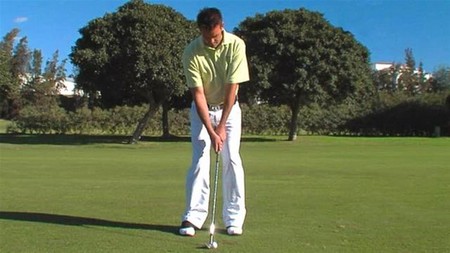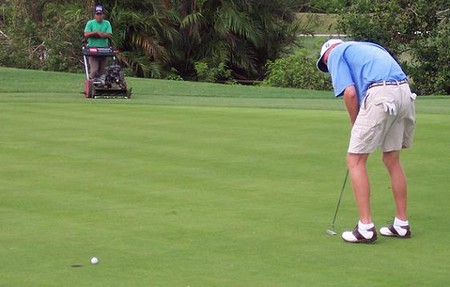Playing a high, soft pitch is your only choice when left with some 30 or 40 yds/m from a good lie to a flag that is just behind a bunker or near the front edge of the green. The chip-and-run and the normal pitch would be unsuitable, as the ball would fly too far or would not stop quickly enough. What is needed is a slow, high shot that will land softly and steeply on the green.
The experienced player has a choice of club here: the pitching wedge or the sand iron. If the lie is very good (sitting up on the grass) and the landing area is small, the sand iron gives you the best chance of success, because it will fly the ball higher and stop it quicker. Less experienced players, however, would do well to take the safer pitching wedge in this situation.
Grip
With either of the clubs just mentioned, you can reach the green easily. Therefore, you can shorten your grip by placing the hands well down on the shaft and still carry the distance required. The shortened grip increases your control and produces a steeper backswing. You want all the height you can get, so the club face must not be allowed to close. To guard against this, place both your hands slightly more to the left on the shaft than you would do for a normal pitch. Furthermore, the shortened grip makes you stand nearer the ball, ensuring a straighter and more upright swing that gets the ball high into the air.
Stance
Take your stance so that the ball is in line with the left heel. Keep your feet 10-12 in (25 – 30 cm) apart, with your weight slightly favouring the right side. The stance is open, with the left foot considerably withdrawn from the target line -about 6 in (15 cm). Keep the left hip pointing well to the left of the flag.
Posture
To facilitate a smooth swing movement through the ball, keep the knees bent so that you are almost in a sitting position. The hands should be directly above the ball (which should be in line with the left heel).
Movement
You will find that the movement back from the ball tends to be much straighter and may even be outside the target line. This depends on the stance and posture you have adopted and ensures that the club-ball contact is such that the ball flies high.
A full, free arm movement with an early wrist break will make sure the backswing is narrow and steep, enabling the club head to descend correctly to the ball, with the hands over the ball at impact, just as they were during address. This, together with the hand position and dominant left side, prevents the club face from closing prematurely. It also ensures that the club strikes the ball at the very bottom of the swing arc and continues through to the inside of the swing line with the left side leading, to give you all the height that is necessary.
The high, soft pitch is not such a difficult shot as many imagine. Of prime importance to its success are stance and set-up. The major difficulty is to remember that because the swing is so slow and produces little power, the length of the swing must be sufficient for the ball to reach the target. Therefore, you must practice the high, soft pitch often, until you have enough experience to know how long a swing you will need in each case.
Should you move the ball back in the stance, with your weight centred and the hands in the normal grip position, and use your arms more, your swing will be shallower, faster and more distinct. This will fly the ball further, in a lower trajectory, and with a considerable amount of back-spin.
So when playing downwind, use the softer, slower arm-and-wrist swing that will give a high trajectory with the ball falling softly on to the green. The wider, shorter and slightly faster backswing would give lower trajectory and more back-spin, which is preferable if you are playing into a strong headwind.
Categories
Advertisements
Recent Articles
 How to Understand Bed Sizes – A Small Guide
How to Understand Bed Sizes – A Small Guide How to Select Some Must Have Kitchen Accessories
How to Select Some Must Have Kitchen Accessories Best Way to Change a Car Tire
Best Way to Change a Car Tire Best Way to Write an Affirmation
Best Way to Write an Affirmation Best Way to Take Charge of Your Financial Life
Best Way to Take Charge of Your Financial Life Best Way to Survive a Party When You Don’t Know Anyone
Best Way to Survive a Party When You Don’t Know Anyone Best Way to Stop Self Sabotaging Yourself
Best Way to Stop Self Sabotaging Yourself Best Way to Start Journal Writing
Best Way to Start Journal Writing Best Way to Speak with a Powerful Voice
Best Way to Speak with a Powerful Voice Best Way to Simplify Your Life
Best Way to Simplify Your Life Best Way to Respond to a Put-Down
Best Way to Respond to a Put-Down Best Way to Reduce Acne Breakouts
Best Way to Reduce Acne Breakouts Best Way to Recover from Dining Disasters
Best Way to Recover from Dining Disasters Best Way to Quit Your Job Gracefully
Best Way to Quit Your Job Gracefully Best Way to Make Your Own Website
Best Way to Make Your Own Website



Leave a Reply